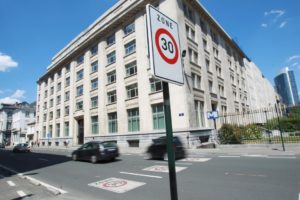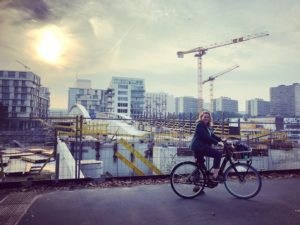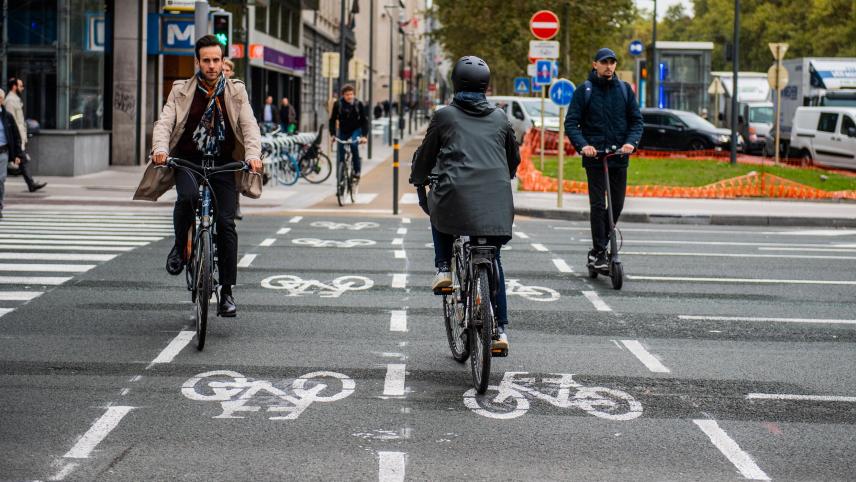Brussels is unrecognisable from a decade ago, according to the politicians who helped lay new bike paths and pedestrianize streets. It still has a lot more to do, but as Sam Morgan reports, it’s on the right track
From the 13th floor window of her office, it is difficult for Brussels Mobility Minister Elke Van den Brandt to point out the sweeping changes she has helped bring to the streets of the capital. But they are most definitely there.
New segregated cycle lanes, pedestrianised areas and a 30km speed limit across much of the city are just some of the mobility perks achieved over the last couple of years, with plenty more in the pipeline. “As soon as you go out you can feel it,” Van den Brandt says. “There is this positive vibe. Cycling home, I used to be alone waiting for the red light to change. Now there's always at least five or ten people waiting every time.”
Cycling infrastructure is one of the most visible developments. Some 40km of extra bike lanes have been installed since the pandemic first struck and it is now nearly possible to cycle all the way from Anderlecht to the European Quarter without having to contend with traffic.
“Corona really pushed the accelerator,” the minister explains. “People that don’t have terraces, don’t have gardens: public spaces are actually part of their homes in a way. So rethinking how we use it has become even more important.”
Cyclist numbers have gone up some 60 percent since the pandemic struck. The Brussels government hopes that figure will continue to rise so traffic congestion can be tackled further and the investments in bike lanes pay off.
The moves to transform Brussels reflect broader trends in both Europe and the world. The European Union wants governments to spend big on active mobility as part of pandemic recovery measures, with one scheme helping European cities go carbon neutral by 2030.
But, as Van den Brandt points out, there were also plenty of protests against the changes, singling out the new bike lanes along Rue Belliard and Rue de la Loi as examples of mobility tweaks that were unpopular at first. “Now we see that they are the most used bike lanes in Brussels,” she says, adding that non-cyclists are happier because pedestrians and motorists no longer contend with two-wheeled commuters. Everyone has their own patch now.
Some challenges are ongoing. Legal action against the temporary ‘lockdown’ bike paths risked undoing some of the work. A court has now given the government two years to legalise the infrastructure so it can stay in place.
Van den Brandt insists motorists protesting the loss of car lanes are a small minority, but there have nonetheless been setbacks in the pandemic-prompted rollout of bike and pedestrian space. A road through the Bois de la Cambre park recently reopened to cars after a court said its closure was unlawful, while plans to redesign the Marché aux Porcs in the city centre contain the same number of parking spaces as before.
Team effort
Van den Brandt is also keen to pay tribute to the work of others before her, including her predecessor as Brussels Mobility Minister, Pascal Smet. Now Brussels State Secretary for Urbanism and Heritage, Smet is still closely involved with how public space is managed in Brussels. He also believes that the city has “evolved a lot” and that mentalities towards mobility are quickly changing.
“People want bike lanes,” he says. “When I started, they shouted at me to go back to Flanders, because people don't bike in Brussels. Today people don't shout that. They shout that they want more bike lanes!”
The guiding force behind mobility policies in Brussels is the Good Move plan, first put together when Smet was in the job, and was approved when Van den Brandt took over. Good Move aims to cut transport greenhouse gas emissions 35 percent by 2030, install 250km of ‘calm zones’ such as pedestrianised areas or low-traffic zones within the capital, and generally improve the city’s transport offering.
Brussels is still synonymous with traffic jams, a point neither Smet nor Van den Brandt refutes, but there are schemes underway that aim to reduce the number of cars coming into the city every day, beyond improving cycling infrastructure.
For the last six months, most roads in Brussels have shifted from a 50km/hour speed limit to 30km, a policy that was given a mixed reception when announced and which continues to provoke the ire of some motorists.

A 30km/h speed limit applies across most of the city. Credit: Belga
However, Van den Brandt is adamant that it is the right decision, as initial data shows that journey times have been largely unaffected by the speed limit reduction and the number of road accidents have reduced. More time is needed to draw firm conclusions though.
“The 30km zone is going to create neighbourhoods and the conditions needed to make walking and cycling more fun and safer,’ she insists, sharing that as a mother she often worries when waving her children off to school in the morning. “That should not be normal,” she adds.
Other factors such as upcoming bans on older, more polluting vehicles could also take more cars off the road, while the issue of company car policy — which is often criticised for encouraging the use of personal over public transport — will have to be dealt with at federal government level.
Transport for all
Public transport in Brussels, as in most cities around the world, took a heavy hit during the pandemic, as passengers either stopped going to workplaces altogether or avoided mass transit in a bid to reduce the risk of Covid infection.
STIB, the capital’s operator of buses, trams and metros, reported a 42.9% drop in 2020 compared with 2019, but it is hoped that the recovery seen already this year can continue in earnest.
New metro carriages, cheaper tickets for students and even new bridges across the city’s canal for both pedestrians and public transport promise to boost numbers. The new bridges in particular could play more than just a logistical role, according to Van den Brandt. “We needed these bridges because of the number of people we know that want to cross there but it is also symbolic, as the water really is a division between two worlds. Hopefully, this can help bring the two communes a bit closer together,” she explains.

Brussels Mobility Minister Elke Van den Brandt
Public transport is not just promising to bring together different parts of Brussels but also different parts of Belgium, as a new unified passenger ticket — the Brupass XL — means that commuters from Wallonia and Flanders can travel hassle-free for the first time.
Flemish Mobility Minister Lydia Peeters says the scheme makes “a huge difference” and that by “keeping it simple and easy to use, it makes public transport attractive” and provides commuters with an alternative, along with the extra bike paths that have been installed.
Peeters stops short of comparing cities like Antwerp and Ghent — both lauded internationally for their mobility progress — with Brussels. But she does acknowledge that both Flanders and Brussels recognise the importance of strong public transport systems. “After all, the more potential travellers, the greater the need for these kinds of publicly available mobility solutions,” she says, adding that Flanders is shifting away from a supply-driven public transport offering to a demand-driven model.
A different league?
Neither Van den Brandt nor Smet want to compare Brussels with other Belgian cities either. Smet insists that “Brussels is playing in a different league” due to its bigger size and different demographics. “Ghent is another scale. It's a town, especially the historic centre. But Brussels is a big capital city, with more commuters and it's the economic heart,” Smet insists, adding that “it's probably true that mentalities changed a lot earlier there but it's also a student city, so that has to be taken into account too.”
There are similarities between what Brussels and Ghent are trying to do, including restricting traffic flow between different neighbourhoods and phasing in low-emission zones. However, the spark for the capital’s changes come from further afield. “Brussels is taking its inspiration from cities like Copenhagen, Barcelona, London, Paris,” Smet says.
Van den Brandt agrees that Belgium’s capital can learn and indeed has already learned from other cities. “Before we put in the 30km zone, I spoke a lot with the mayors of Grenoble and Helsinki, as they already had results from doing it themselves,” she says. The Finnish capital recorded no fatalities after making the change, while in Grenoble the number of injuries halved.
Van den Brandt says Brussels still has plenty of room to improve the way people move around the city – and even hopes that it will someday inspire other cities around the world. For anyone who remembers what Boulevard Anspach and Place Jourdan used to look like before cars were banished, that hope is not so fetched. "Change takes time,” she says. “The idea is to change a city designed to host cars into a city for people. We're making a better city that is nicer to live in, nicer to visit."

